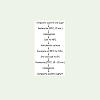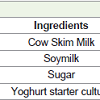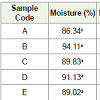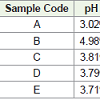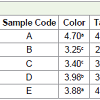Research Article
Production and Evaluation of Composite Soymilk Yoghurt
Akusu OM and Wordu GO*
Department of Food Science and Technology, Rivers State University of Science and Technology, Port-Harcourt, Rivers State, Nigeria
Corresponding author: Wordu GO, Department of Food Science and Technology, Rivers State University of Science and Technology, Port-Harcourt, Rivers State, Nigeria; E-mail: wordugab@yahoo.com
Citation: Akusu OM, Wordu GO. Production and Evaluation of Composite Soymilk Yoghurt. Indian J Nutri 2017; 4(4): 168.
Copyright © 2017 Akusu OM and Wordu GO. This is an open access article distributed under the Creative Commons Attribution License, which permits unrestricted use, distribution, and reproduction in any medium, provided the original work is properly cited.
Indian Journal of Nutrition | ISSN: 2395-2326 | Volume: 4, Issue: 4
Submission: 14/11/2016; Accepted: 23/08/2017; Published: 19/09/2017
Abstract
Composite soymilk yoghurt was produced from composite blends of cow skim milk: Soymilk in a ratio of 100:0% (Sample A), 0:100% (Sample B), 50:50% (Sample C), 60:40% (Sample D) and 40:60% (Sample E). Each composite blend milk samples was pasteurized at 85°C for 15 min, cooled and homogenized and inoculated with a mixed yoghurt starter culture of Streptoccus thermophilus and Lactobacillus bulgaricus at 45°C for 12hr and further pasteurized and homogenized. The proximate, physicochemical properties and sensory evaluation of the composite soymilk yoghurt samples were determined. The result of this study reveals that there was a significant decrease (p>0.05) in protein content from 4.2% (Sample A) to 2.95% (Sample D) as the level of soymilk substitution in the yoghurt increased from 40% (Sample E) to 60% Sample D. Titratable acidity of the control Sample A was very high, 1.24% Lactic acid however the titratable acidity of soymilk yoghurt (Sample B) was very low 0.51% lactic acid whereas the titratable acidity of the composite yoghurts (Samples C, D and E) were within the limits of a good yoghurt (0.85-0.90% lactic acid). The mean sensory scores of the yoghurt samples reveals there was a significant difference (p>0.05) in terms of taste, smoothness and overall acceptability between Sample A (control) and the composite soymilk yoghurt samples (Samples B, C and D) except for Sample E that was not significantly (p<0.05) different from Sample A. Therefore in the production of yoghurt, soymilk can be substituted up to 40% in normal cow milk yoghurt preparation without affecting the proximate, physicochemical and sensory properties of the yoghurt.
Keywords:
Composite soymilk yoghurt; Skim milk; Titratable acidity; Yoghurt starter culture
Introduction
Yoghurt is one of the oldest fermented milk products known in human history. It is produced by inoculating concentrated milk with a yoghurt starter culture consisting of a mixture of homofermentative lactic acid bacteria, Strephococcus thermophilus and Lactobacillus bulgaricus at 45°C until the pH of about 4.0 is attained and cooled rapidly to about 4°C [1]. Yoghurt is consumed for its refreshing and appealing flavour, biotherapy and versatility. However most of the industrialize yoghurt production utilize milk from cow. Cow milk gives yoghurt its unique characteristic [2].
Owing to ever increasing cost of cow milk, attempt is being made to find cow milk substitute for the production of yoghurt. Health is one of the biggest motivating factors in consumers’ decision making process in the consumption of fruit juice and yoghurt products.
Soymilk has been found to have close similarities with cow milk and Kanda et al, 1976 successful use of soymilk in yoghurt productionwill not only improve the nutritional status of the poverty strickenmasses but also reduce the fears associated with high blood cholesteroland lactose of avid consumers of cow milk [3-5].
Wide spread acceptability of soymilk by consumers is been hindered by the intrinsic beany flavor associated with soybean [6,7]. Thus in a bid to win consumers appeal, composite soymilk yoghurt was innovatively formulated and produced to meet the need of both the young ones who do not bother about cholesterol as well as the increasing number of lactose intolerance children and the adult consumers who want a healthy soymilk yoghurt that has a low cholesterol level; leading to a healthy active life and good taste with smooth texture [8,9].
This study therefore is aimed at producing and conducting sensory evaluation of the composite soymilk yoghurt that address the needs of the health conscious yoghurt consumers especially lactose intolerance and cardiovascular problems caused by the consumption of cholesterol based cow milk yoghurt as well as reducing the cost of yoghurt in the market.
Materials and Methods
Materials
Soybean, skim milk powder and granulated sugar, were purchased from a local market in Port Harcourt, Nigeria. Yoghurt starter culture was sourced from a market in Lagos. All chemical used were of their analytical grade, products of BDH Chemical Ltd. Pool. England.
Methods
Four (400 g) of soybean was soaked in 1200 ml of distilled water for 12 hours to obtain a bean to water ratio of (1:4). The soybean was blanched in 2L of boiling 0.05% NaHCO3 in a cooking pot for 15 min. The blanched soybean was hand dehulled and the hulls removed by floatation. The blanched soybean cotyledons were then used for soymilk extraction (Figure 1).
Production of cow milk yoghurt: Cow milk yoghurt was produced using 150 g of skim milk powder and 40 g of granulatedsugar dissolved and made up to one liter of boiled distilled water. The yoghurt production was based on Richard (2001) method as stated in (Figure 2) [1].
Production of composite soymilk yoghurt: Production of composite soymilk yoghurt was based on the recipe as shown in Table 1 where soymilk was blended with cow skim milk and processed according to Figure 3.
Proximate analysis of yoghurt: Moisture, fat, crude protein, carbohydrate ash and crude fiber was determined by AOAC (2006) standard methods. While pH and titratable acidity was determined according to the method of Pearson (1991) [10].
Sensory evaluation of composite soymilk yoghurt: Theyoghurt produced was evaluated organoleptically for color, taste, aroma, smoothness and overall acceptability. A twenty member panel consisting of students of the Department of Food Science and Technology was selected based on their familiarity with the consumption of yoghurt.
A 9 point hedonic scale was used to evaluate the organoleptic parameter of color, taste, aroma, smoothness and overall acceptability. Each sensory attribute was rated on the 9 point hedonic scale where 1 = dislike extremely, 5 = neither like nor dislike and 9 = like extremely.
Statistical analysis: The data obtained was subjected to analysis of variance (AVOVA).
Results and Discussion
The proximate composition of the composite soymilk is shown in Table 2 with sample A as control (skim milk yoghurt). There was a significant difference (p>0.05) in the protein content of sample A (skim milk yoghurt (4.29%) and that of soymilk yoghurt (sample B) (3.01%).
The table reveals that the protein content decreased significantly (p>0.05) from 4.2% (sample A, control) to 2.95% (sample D) as the level of soymilk substitution in the yoghurt increased gradually from 40% (sample E) to 60% (sample D).
The physiochemical properties of the composite soymilk yoghurtare shown in Table 3.
The total solids of the yoghurt decreased significantly (p>0.05) from 13.66% for 100% skim milk yoghurt (sample A) to 5.8% for 100% soymilk yoghurt however as the level of soymilk substitution increases from 40% sample E to 100% sample B, the total solids decreased significantly (p>0.05).
Titratable acidity of the control yoghurt (sample A) was very high as expected whereas that of the soymilk yoghurt (sample B) was very low. Ukwo and Edima-Nyah (2015) reported that titratable of yoghurt samples decreases as the level of soymilk substitution increases [11].
The titratable acidity of the composite yoghurt (samples C, D and E) was within the limits of good yoghurt. Jay 1978 stated that the titratable acidity of good finished yoghurt should be in the range of 0.85-0.90% [12].
Lactic acid as index of titratable acidity is the main product of yoghurt fermentation, although minor products such as the butter flavour substance biacetyl are also produced [13]. The high value of the titratable acidity of sample A may be due to the fact that cow milk contains lactose which is broken down to lactic acid [14-18].
Table 4 shows the mean sensory scores of the composite soymilk yogurt. There was a significant (p<0.05) difference in all the sensory attributes between the cow milk yoghurt (sample A, control) and the soymilk composite yoghurt (sample B, C, D, and E) except for aroma. There was no significant difference (p>0.05) in the aroma between all the samples Eluchie et al. (2011) reported similar observation [14]. This could be attributed to the production of the yoghurt butter flavour substance biacetyl by the mixed starter yoghurt culture [13].
In terms of taste, smoothness and overall acceptability, there was a significant (p>0.05) difference between sample A (control) and the composite soymilk yoghurt (sample B, C, D) except for sample E that was not significantly different (p<0.05) from sample A. Thus in the production of yoghurt, soymilk can be substituted up to 40% in normal cow milk yoghurt preparation without affecting the proximate, physicochemical and sensory properties of the yoghurt.
Conclusion
Good soymilk composite yoghurt comparable to cow milk yoghurt can be produced by substituting soymilk up to 40% in the cow milk yoghurt formulation and still maintain the organoleptic qualities found in normal cow milk yoghurt.
References
- Richard L (2008) Microbiology handbook: Dairy products, (2nd edn). In: Femandes R (Ed), Fermented milk. Leatherhead publishing, Leatherhead, UK, pp. 77-89.
- Barnes DL, Harper SJ, Bodyfelt FW, McDaniel MR (1991) Predication of consumer acceptability of yoghurt by sensory and analytical measures of sweetness and sourness. J Dairy Sci 74: 3746-3754.
- Ohr ML (2003) The latest scoops on soy. Food Technol 57: 87-91.
- Kanda H, Wang HL, Hesseltine CW, Warner K (1976) Yoghurt production by Lactobacillus fermentation of soybean milk. Proc Biochem 1: 23-25.
- Akyrod WR, Doughty J (1982) Legumes in human nutrition. FAO Food Nutr Pap 20: 1-152.
- Olson AC, Gray GM, Gumbmann MR, Sell CR, Wagner JR (1981) Flatwence causing factors in legumes. In: Antinutrientes and natural toxicants in foods. Food and Nutrition press Inc, Westport, Pp. 275-294.
- Sipos EF (1988) Edible uses of soybean protein. University of Minnesota, Minneapolis, MN.
- Buono MA, Setser C, Erickson LE, Fung DY (1990) Soymilk yoghurt: Sensory evaluation and chemical measurement. J Food Sci 55: 528-531.
- Pinthong R, Macrae R, Rothwell J (1980) The development of soya-based yoghurt. I. Acid production by lactic acid bacteria. Int J Food Sci Techn 15: 647-652.
- Horwitz W (2005) Official method of analysis, (18th edn). AOAC International, Washington, DC.
- Ukwo SP (2015) Physiochemical, profile and sensory attributes of plain yoghurt from cow milk and soymilk blends. Nigerian J Agric Environ 11: 20-23.
- Jay MJ, Loessner MJ, Golden DA (2005) Modern food microbiology, (7th edn). Springer, USA, pp. 1-715.
- Brain JB Wood (1998) Microbiology of fermentated food, (2nd edn). Blackie Academic & Professional, New york, Pp. 1-851.
- Eluchie CN, Amandikwa C, Ahaotu NN (2011) Sensory properties of the traditional and industrial yoghurts from soymilk and cow milk powder proceedings of the 35th Annual Conference/AGM of the Nigerian Institute of Food Science and Technology. Nigeria.
- Ahmed M (1984) Soybean: The meat that grows on plants. Fanners Bulletin No. 1617 U.S.D.A.
- Igyor MA, Igbian EK, Iorbo CI (2006) Effects of soymilk supplement on the yield and quality of “Warankasiâ€. Nig Food J 24: 92-97.
- Tamime AY, Deeth HC (1980) Yoghurt technology and biochemistry. J Food Protection 43: Pp. 939.
- Wilkens WF, Mattick LR, Hand DB (1967) Effects of processing method on oxidative off-flavors of soybean milk. Food Technol 21: 86-89.



